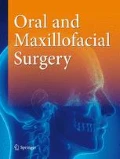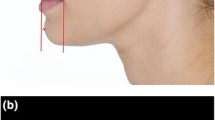Abstract
Introduction
Currently, the majority of research in facial analysis using computational morphing methods focuses exclusively on analysis of frontal facial projections. Lateral facial morphing analysis has not been extensively investigated, and landmark features critical to specify registry points are unknown. This study aims to (1) determine the quantity of registry points (RP) required to create realistic lateral faces and (2) determine key facial registry point landmarks required to create synthetic lateral faces.
Method
36 synthetic lateral faces with a 50 to 250 RP were created to determine the ideal quantity of RP to create a realistic lateral image; ear, eyebrow, eye, nose, lips, hairline, facial outline, and overall outline were evaluated by an expert panel of seven evaluators using a 1 to 5 point Lickert scale rating system.
Result
ANOVA single-variable analyses revealed significant differences when comparing templates of 200 and 250 RP with 50 and 100 RP templates (p < 0.05). Furthermore, analysis of all key landmark areas of the face indicated significant differences between different registry points except for 200 and 250 registry point markers. Kruskal-Wallis statistical analysis revealed the landmarks varied significantly from 50 to 200 RP,but had no significance with 200 and 250 RP.
Conclusion
The most ideal quantity of RP used for the creation of realistic lateral faces was in the range of 200 RP. Defined lateral facial registry point landmarks generated successful realistic faces.






Similar content being viewed by others
References
Rhodes G (2006) The evolutionary psychology of facial beauty. Annu Rev Psychol 57:199–226
Wong BJF, Karimi K, Devcic Z, McLaren CE, Chen PW (2008) Evolving attractive faces using morphing technology and a genetic algorithm: a new approach to determining facial aesthetics. Laryngoscope 118:962–974
Enquist M, Ghirlanda S (1998) Evolutionary biology: the secrets of faces. Nature 394:826–827
Schendel SA, Delaire J (1980) Surgical correction of dentofacial deformities. In: Bell WH, White RP (eds) Facial muscles for, function and reconstruction in dentofacial deformities. WB Saunders, Philadelphia, pp 259–280
Wolford L (1988) Lip-nasal aesthetics following Le Fort 1 osteotomy. Plast Reconstr Surg 81:180
Farkas LG (1994) Anthropometry of the head and face. Raven Press, New York, p 405
Johnston VS, Solomon CJ, Gibson SJ, Pallares-Bejarano (2003) Human facial beauty: current theories and methodologies. Arch Facial Plast Surg 5:371–377
Pearson DC, Adamson PA (2004) The ideal nasal profile: rhinoplasty patients vs. the general public. Arch Facial Plast Surg 6:257–262
Little AC, Perrett DI (2007) Using composite images to assess accuracy in personality attribution to faces. Br J Psychol 8:111–126
Ahem O, Dhinsa A, Popenko N, Osann K, Crumley RL, Wong BJ (2014) Population-based assessment of currently proposed ideals of nasal tip projection and rotation in young women. JAMA Facial Plast Surg 16(5):310–318
Devcic Z, Karimi K, Popenko N, Wong BJ (2010) A web-based method for rating facial attractiveness. Laryngoscope 120(5):902–906
Devcic Z, Rayikanti BA, Hevia JP, Popenko NA, Karimi K, Wong BJ (2011) Nasal tip projection and facial attractiveness. Laryngoscope 121(7):1388–1394
Popenko NA, Devcic Z, Karimi K, Wong BJ (2012) The virtual focus group: a modern methodology for facial attractiveness rating. Plast Reconstr Surg 130(3):455e–461e
Little AC, Jones BC, DeBruine LM (2011) Facial attractiveness: evolutionary based research. Philos Trans R Soc Lond B Biol Sci 366(1571):1638–1659
Hupp JR (2008) Contemporary oral and maxillofacial surgery, 5th edn. Mosby, Missouri, p 1223–1234
Acknowledgments
The authors would like to thank Cyrus Manuel, Dr. Holli Riter, and Dr. Brian Novy for their evaluations and continual support of the project and ideas.
Author information
Authors and Affiliations
Corresponding author
Rights and permissions
About this article
Cite this article
Karimi, K., Devcic, Z., Popenko, N. et al. Morphometric facial analysis: a methodology to create lateral facial images. Oral Maxillofac Surg 19, 403–410 (2015). https://doi.org/10.1007/s10006-015-0512-7
Received:
Accepted:
Published:
Issue Date:
DOI: https://doi.org/10.1007/s10006-015-0512-7




